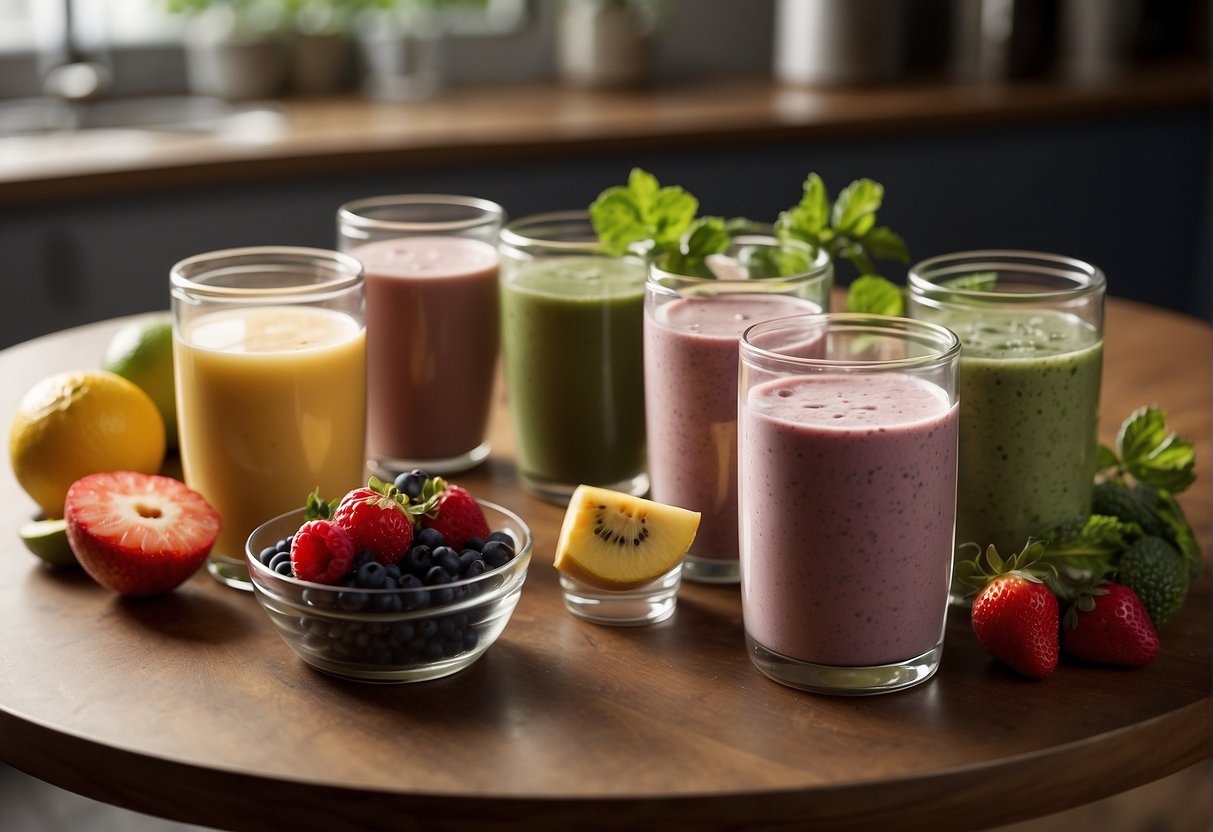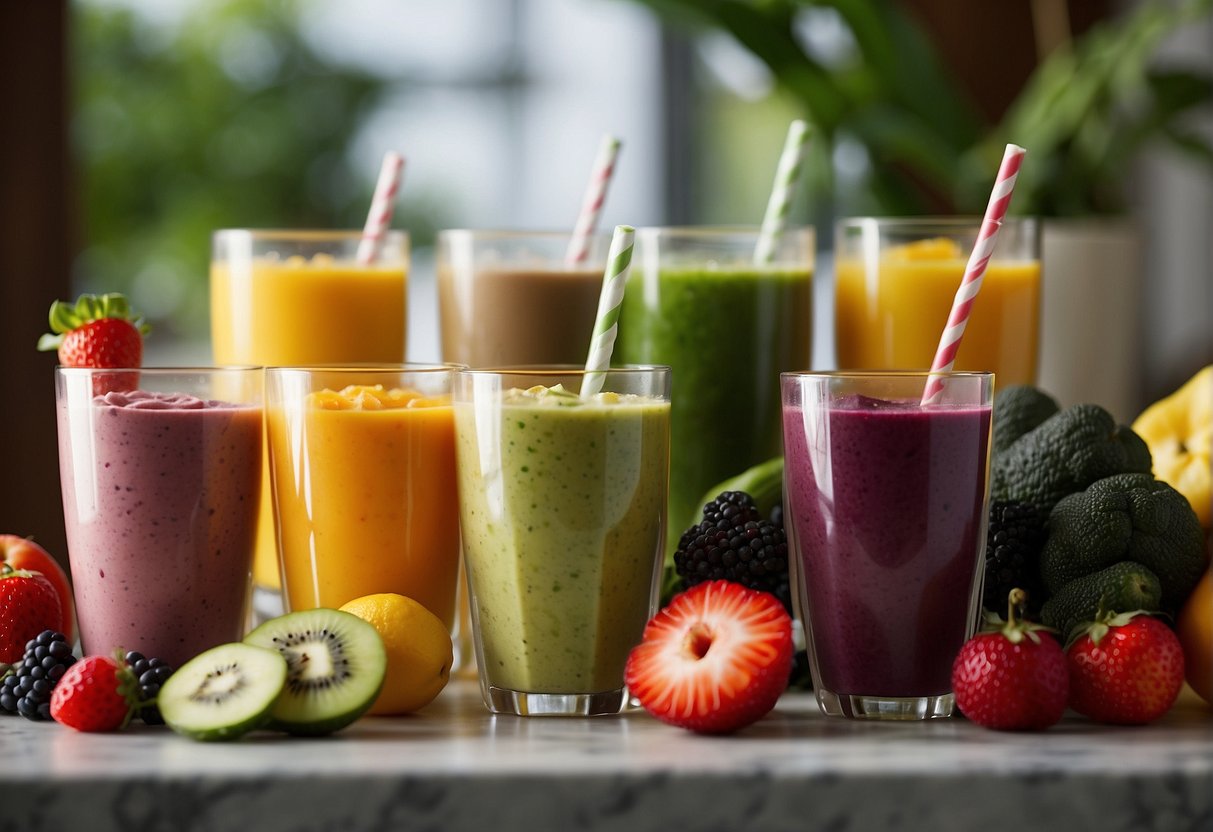Health Impacts of Smoothie Ingredients

When I blend up a smoothie, I’m packing in a variety of ingredients that can affect my health in different ways. From the vitamins and minerals to the sugars and fats, each component plays a part in the overall nutritional value of my smoothie.
Nutritional Content and Calories
Fruits and vegetables are the stars in any smoothie, offering a range of essential nutrients like vitamins, minerals, and antioxidants. While these ingredients boost the nutrient density, it’s important to keep an eye on the calorie count. For instance, avocados and bananas add creaminess but also come with a higher calorie tag, which can be a concern if I’m watching my weight.
Added Sugars and Sweeteners
I’ve noticed that many of us have a sweet tooth and might toss in some honey or other sweeteners to enhance the flavor of our smoothies. While that’s tasty, it also increases the added sugar content. This can be a problem if I consume more than the recommended limit for added sugars, potentially leading to weight gain and impacting blood sugar levels.
Dairy and Plant-Based Milks
Milk adds creaminess and a source of protein and calcium to a smoothie. But depending on whether I choose dairy milk or a plant-based alternative like almond milk, it can change the smoothie’s nutritional profile. Plant-based milks often have added vitamins and minerals but may have less protein unless they’re fortified.
Fats in Nuts and Seeds
Adding nuts and seeds, such as chia seeds, isn’t just for texture. They contribute healthy fats and make my smoothie more filling. But these ingredients are also calorie-dense, so I keep portions in check to avoid unknowingly increasing my calorie intake more than necessary.
Impact on Blood Sugar and Diabetes
Smoothies can have a significant impact on blood sugar levels, especially for someone with diabetes. Ingredients high in sugar or high-glycemic fruits can cause blood sugar spikes. However, incorporating fiber-rich whole fruits and oats can help regulate this impact.
Fiber and Digestive Health
I aim to add fiber-rich ingredients like whole fruits and vegetables to support my digestion. Fiber slows the absorption of sugar, which can prevent blood sugar spikes and support a healthy gut. Plus, it makes my smoothies more satiating, which is great for my digestive health and hunger management.
Benefits of Smoothie Consumption
I’ve found that incorporating smoothies into my diet provides a whole host of advantages, from helping with weight management to ensuring I get my daily dose of nutrients. Let me break down just how sipping on these blended delights can be beneficial for health.
Weight Loss and Management
I noticed that when I choose a smoothie loaded with fiber-rich fruits and vegetables, it can help me feel full, which prevents overeating. Ingredients like berries, spinach, and kale not only contribute few calories, but they also provide a sense of satiety. In fact, I’ve seen that some people use smoothies as a meal replacement which, when done mindfully, can contribute to weight loss efforts.
Convenience and Satiation
Smoothies are a quick and easy way for me to fuel up, especially on the go. They require little prep time, and I can pack them with a variety of fruits and vegetables, nuts, and seeds, creating a meal that satisfies my hunger. This blend of natural sugars and fibers provides a steady release of energy without the crash I might get from less nutritious snacks.
Enhancement of Nutrient Intake
One major plus of drinking smoothies is the enhancement of nutrient intake. I toss in dark, leafy greens for vitamin K and cruciferous vegetables like cauliflower for their health benefits. I also love adding hemp or protein powder to ramp up the protein content. It’s an appealing way to sneak in those vitamins, antioxidants, and additional nutrition that I might otherwise miss out on.
Support for Healthy Lifestyle
For me, smoothies are a cornerstone of a health-conscious lifestyle. Using ingredients like banana for potassium and nuts for healthy fats, I’m able to create a nutritious concoction that supports my wellness journey. They are not just refreshing but also align with my goal to consume more antioxidants and vitamins without having to resort to supplements. Smoothies make getting my daily dose of health-promoting nutrients a breeze.
Risks and Considerations
When I whip up a smoothie, I’m mindful of the potential health risks associated with these drinks. It’s easy to assume they’re always healthy, but there are a few things I consider to avoid unintended consequences.
For starters, the sugar content in smoothies can be pretty high, especially if I use lots of fruit or fruit juice. This could potentially impact my blood sugar levels, which is a concern for managing diabetes or preventing it. Even natural sugars found in fruits can add up, which makes it crucial to moderate my intake.
Another aspect I keep an eye on is the calorie count. Smoothies might seem like a light meal or snack, but they can be quite calorie-dense, particularly with ingredients like nuts and seeds. This is something I watch out for to maintain a healthy weight and reduce the risk of obesity.
It’s also important to mention that some smoothies may interact with medication I’m taking, affecting my body’s response. For instance, certain ingredients, like grapefruit, can interfere with cholesterol medications.
| Nutrient | Concern |
|---|---|
| Fruits/Juices High in Oxalates | Can contribute to kidney stones |
| High Carbohydrates | May increase risk for type 2 diabetes and heart disease |
| Calcium-rich Additives | Excessive amounts might affect risk of osteoporosis |
Not all risks are obvious, though. Some ingredients may seemingly benefit my health but could be harmful if consumed in large quantities. I learned that carrots are nutritious, but too much can lead to an excess of carotenoids in my body.
Lastly, consuming high-carb ingredients frequently can contribute to chronic diseases. I strike a balance in my smoothie blends to ensure that I’m not just enjoying the taste but also taking care of my long-term health.
Choosing the Right Ingredients

When I whip up a smoothie, I think of it as a balancing act. It’s crucial to pick ingredients that bring not just flavor but also nutrients to the table. I start with a fruit base—berries are a mainstay for me due to their low calorie count and high antioxidant content. Mixing in a banana not only gives a creamy texture but also accounts for my potassium needs.
To amplify the nutrient profile, I toss in greens like spinach, kale, or even arugula. These veggies are jam-packed with vitamins, especially Vitamin A. Now, for a touch of sweetness without the overload, I opt for a date or two instead of added sugar.
Here’s how I like to bulk up my smoothie:
- Proteins: Boosting protein intake is straightforward with a dollop of Greek yogurt or a spoonful of chia seeds.
- Healthy Fats: I go for avocado or a handful of nuts, particularly almonds, for their healthy fats.
- Liquids: Plain old water is my go-to, but unsweetened almond milk can add creaminess without too many extras.
- Spices and Extras: To zest things up, I don’t hesitate to sprinkle in cinnamon, turmeric, or ginger—powerhouses of flavor and health benefits.
I’m careful with the so-called healthy add-ons like juices and sugar. It’s easy to turn a smoothie into a calorie bomb, so juices can be deceptive with their high sugar content. I avoid them and stay clear of too much added sugar.
Bottom line, choosing the right smoothie ingredients is key to keeping it not just tasty but also reflective of my dietary goals—combining fruits, vegetables, and other nutrient-dense foods to maintain a balanced diet.
Smoothie Preparation Techniques

When I whip up a smoothie, my goal is to balance taste and nutrition. Here’s how I make sure my smoothies are both delicious and healthy.
Choosing Your Base: I often start with a liquid like almond milk or coconut water as a base—it’s the flow to my smoothie’s groove! For a creamier texture, I might add some yogurt or even a bit of avocado.
The Fruits and Veggies: I love tossing in a mix of fresh or frozen fruits and veggies. Berries, mango, banana, and pineapple add natural sweetness, while spinach or cucumber slide in those veggies without overpowering the taste.
Seeds and Nuts: To bump up the nutrition, I sprinkle in some chia seeds or a spoon of hemp seeds for omega-3s and a bit of nut butter for healthy fats. These are great for keeping inflammation at bay and improving digestion.
The Spice of Life: Sometimes I’ll add a dash of cinnamon or turmeric for an anti-inflammatory boost, or a bit of ginger for zing and digestive health.
Sweeten Smartly: I avoid added sugars by sweetening my smoothie naturally. A little honey, a few dates, or some ripe banana can do the trick without going overboard.
| Ingredients | Why I Use Them |
|---|---|
| Almond Milk | A low-calorie, dairy-free base |
| Berries | Antioxidants and sweetness |
| Spinach | Vitamins and minerals |
| Chia Seeds | Fiber and omega-3s |
| Cinnamon | Blood sugar regulation |
Lastly, all of this goodness needs something to blend it to perfection—I use a high-powered blender to create a smooth consistency.
Remember, the key to a good smoothie is using ingredients that are nutritious and make you feel satisfied. It’s not just about dumping things in; it’s about creating a balanced, filling, and convenient meal or snack.
Blend Types and Varieties

When I whip up smoothies, there’s a whole rainbow of types I can create. My go-to is often a classic fruit smoothie, chock-full of vitamins and natural sweetness from the likes of bananas, mangoes, and pineapples. I focus on using whole fruits to maximize the health benefits and minimize added sugar – it’s all about getting that natural fructose without the unnecessary extras.
Sometimes, I’ll throw in veggies like spinach or kale, which not only give my drink a vibrant green hue but also inject a potent dose of vitamins A and K. Adding a bit of cucumber or beetroot doesn’t just offer a nutritional boost; it brings in freshness and a touch of earthy flavors. When I want to add a bit of zing, a piece of ginger or a sprinkle of cinnamon can turn a simple drink into a powerhouse of taste and nutrients.
| Type | Ingredients | Benefits |
|---|---|---|
| Fruit Smoothie | Bananas, mango, apple | Rich in vitamins, potassium |
| Green Smoothie | Spinach, arugula, celery | High in vitamin A & K, antioxidants |
| Protein Shake | Hemp, protein powder, almond milk | Supports muscle repair, can aid weight loss |
| Detox Smoothie | Turmeric, lemon, water, ginger | Promotes digestion, anti-inflammatory |
For those looking for a more filling option, I’d suggest a protein smoothie. They’re fantastic as a meal replacement or a post-workout snack. I’ll blend in hemp seeds, a scoop of protein powder, or some Greek yogurt for that creamy texture and protein punch. Nut butters or avocados can add healthy fats that keep me satisfied and energized throughout the day.
To keep things interesting, I often experiment with nut milks like almond or cashew – they offer a dairy-free way to get that creamy smoothie consistency plus a slight nutty essence which personally, I love. Sweeteners, if needed, come from honey or dates, since I avoid processed sugars.
However, I do keep an eye on my smoothie habits. Overindulgence could potentially lead to weight gain or impact my sugar levels, especially with ingredients like fruit juice, which is often high in sugar. Listening to my body and understanding how different ingredients interact with any medication or health conditions – like how some might increase the risk of kidney stones or inflammation – is crucial. Health is wealth, after all, so balancing flavors with nutrition is my mantra when blending up these versatile drinks.
Frequently Asked Questions

I get a lot of questions about smoothies and their health implications. Let’s address some of the most common concerns.
What might be the downsides to drinking smoothies daily?
Drinking smoothies every day could contribute to excessive calorie intake if you’re not careful with the ingredients. They can be high in sugars and calories, especially if they include sweetened yogurt, fruit juices, or added sugars.
Could regular consumption of smoothies lead to digestive issues?
Yes, routine smoothie consumption can potentially affect digestion. Some individuals may experience bloating or discomfort from the high fructose content in fruit-packed smoothies or difficulty digesting high fiber if they aren’t used to it.
Do homemade smoothies carry any health risks compared to store-bought options?
Homemade smoothies might be healthier because I can control the ingredients and avoid added sugars and preservatives. However, it’s important to ensure kitchen equipment is clean to avoid foodborne illnesses, which can be a risk if not properly managed.
Is there a difference in sugar content between whole fruit and blended fruit in smoothies?
Yes, while the sugar is the same, the blending process can cause you to consume more sugar more quickly than you might from whole fruits, which could have a greater impact on your blood sugar levels due to reduced fiber content.
How do smoothies impact weight loss efforts?
Smoothies can be either helpful or detrimental in weight loss, depending on their composition. A smoothie with a balance of protein, fiber, and healthy fats may promote satiety, but a high-calorie smoothie could contribute to weight gain if it causes you to exceed your daily caloric needs.
Can smoothies actually benefit skin health, or is that just a myth?
There’s some truth here. Smoothies rich in vitamins A, C, and E can support skin health. For example, a smoothie with kale and blueberries can help due to their antioxidant properties, but they’re not a cure-all for skin issues.
